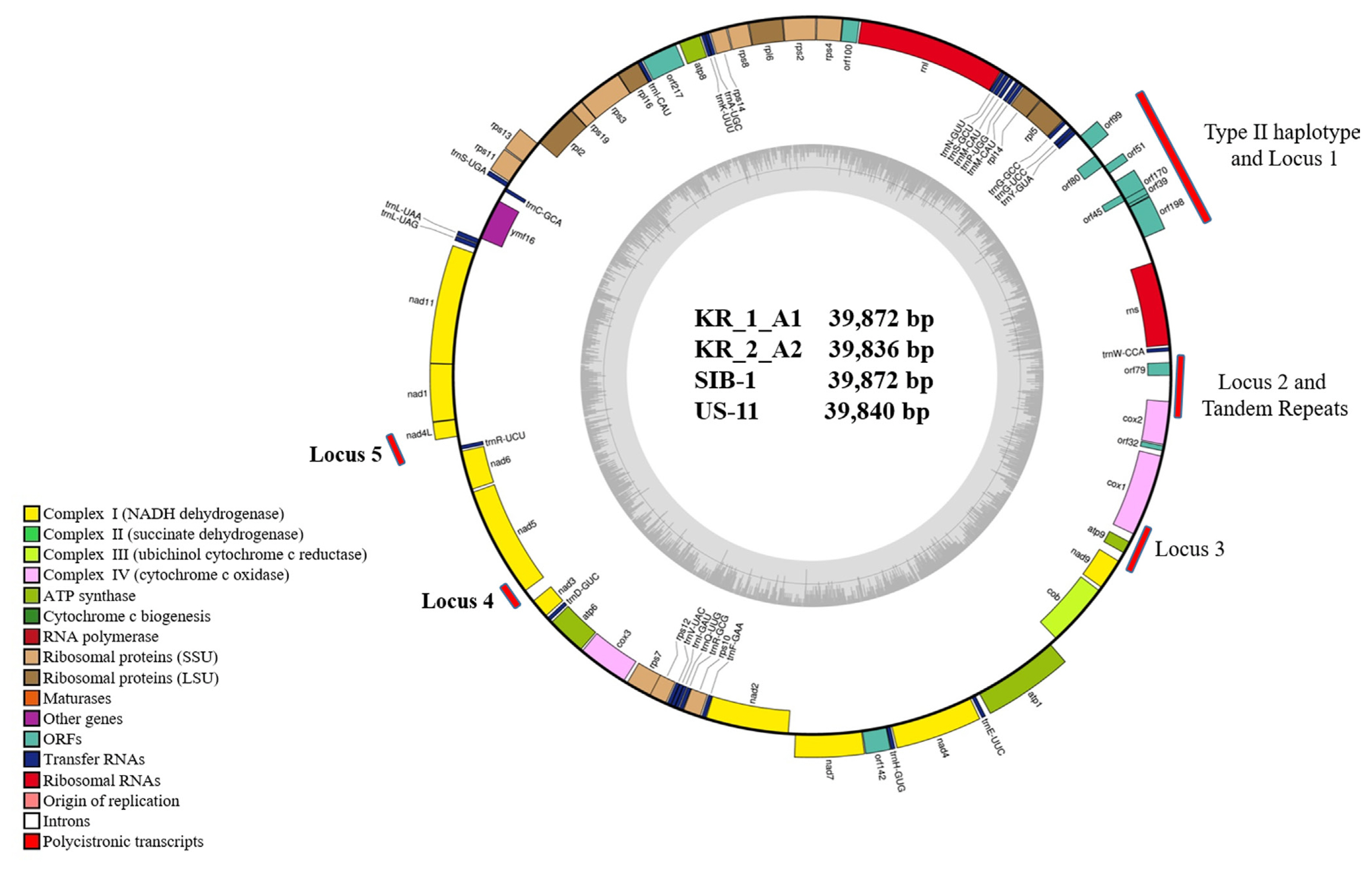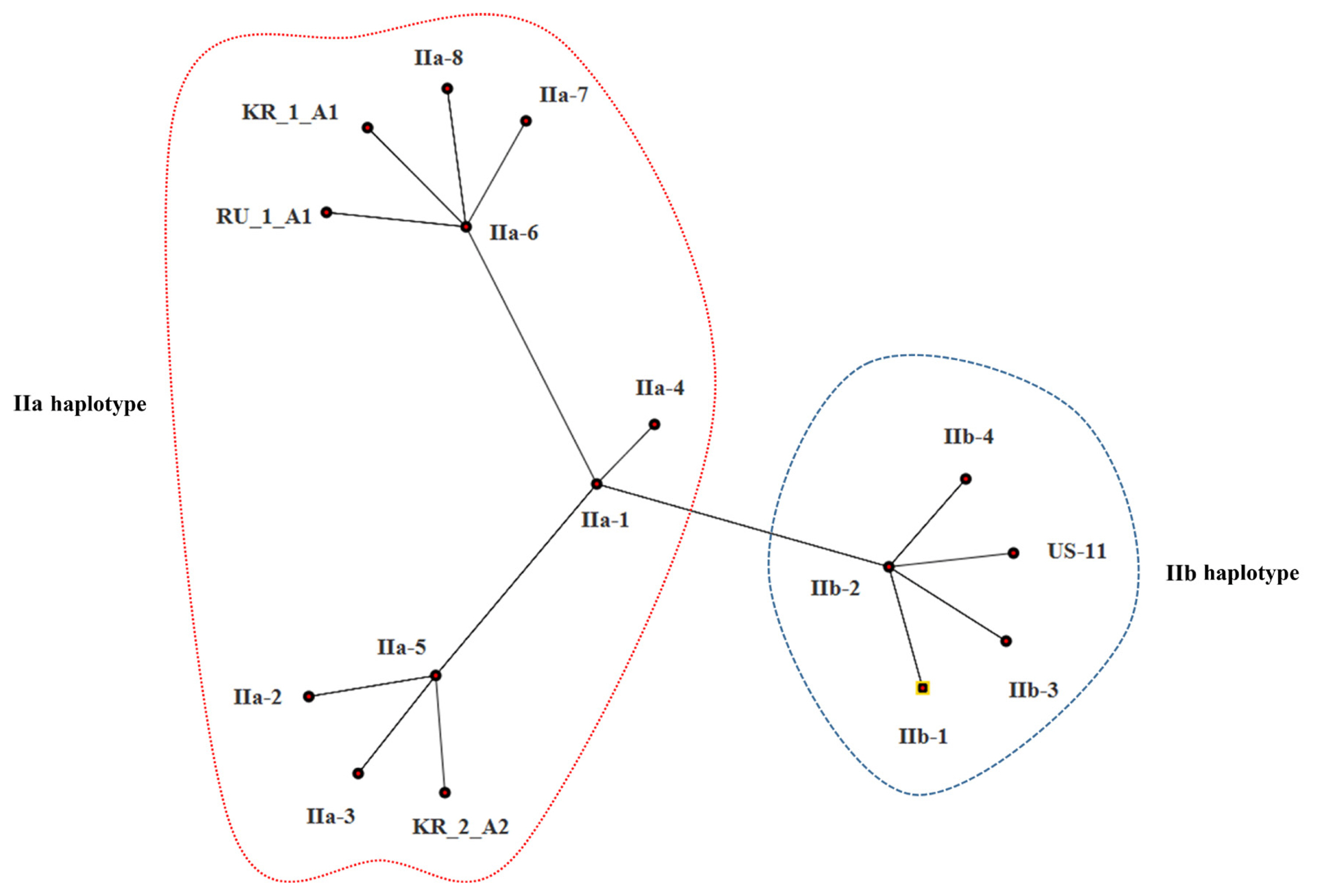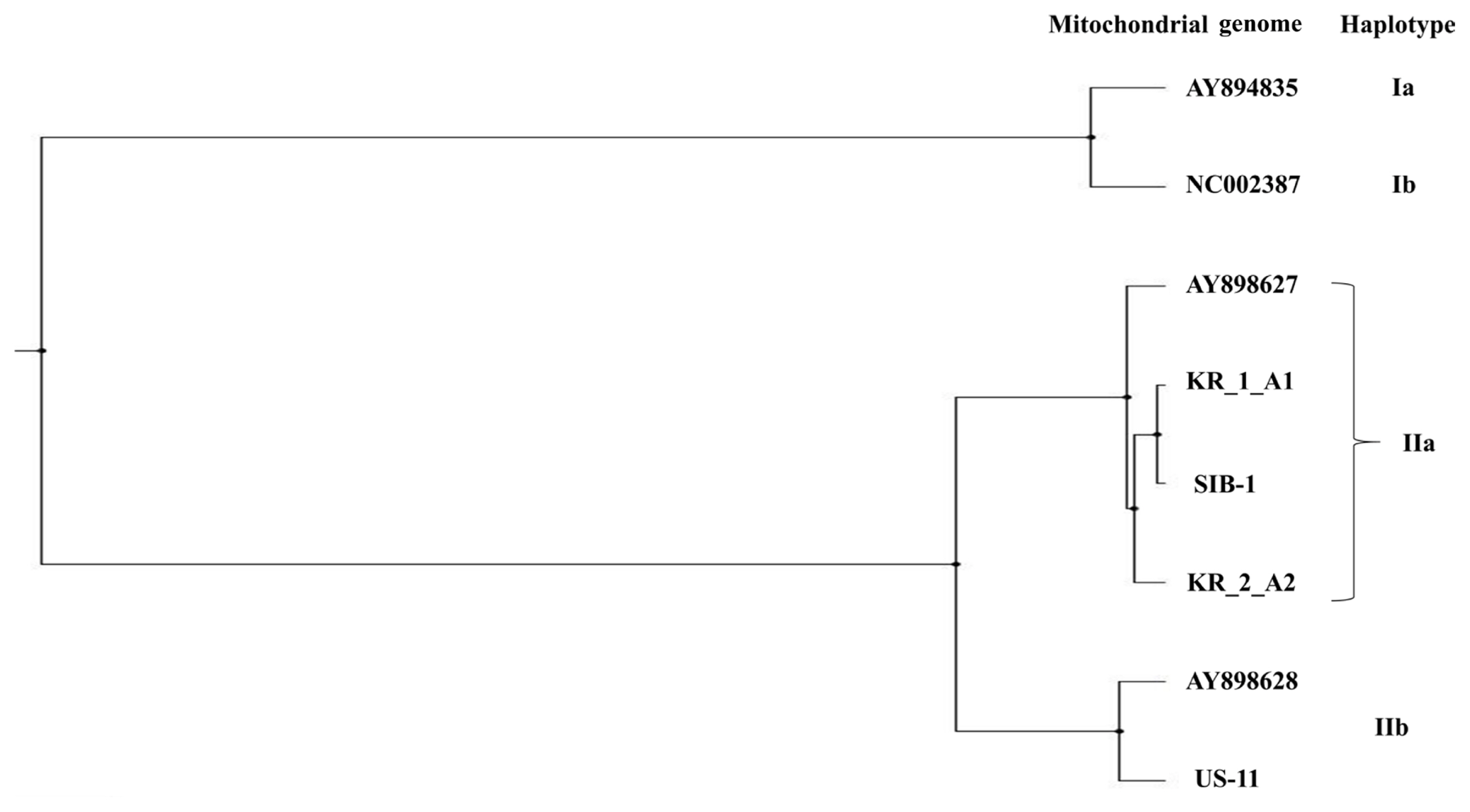Akino, S, Takemoto, D and Hosaka, K 2014.
Phytophthora infestans: a review of past and current studies on potato late blight.
J. Gen. Plant Pathol 80:24-37.


Arora, RK, Sharma, S and Singh, BP 2014. Late blight disease of potato and its management. Potato J 41:16-40.
Avila-Adame, C, Gómez-Alpizar, L, Zismann, V, Jones, KM, Buell, CR and Ristaino, JB 2006. Mitochondrial genome sequences and molecular evolution of the Irish potato famine pathogen. Phytophthora infestans. Curr. Genet 49:39-46.
Cárdenas, M, Grajales, A, Sierra, R, Rojas, A, González-Almario, A, Vargas, A, Marín, M, Fermín, G, Lagos, LE, Grünwald, NJ, Bernal, A, Salazar, C and Restrepo, S 2011. Genetic diversity of
Phytophthora infestans in the Northern Andean region.
BMC Genet 12:23.



Carter, DA, Archer, SA, Buck, KW, Shaw, DS and Shattock, RC 1990. Restriction fragment length polymorphisms of mitochondrial DNA of
Phytophthora infestans
.
Mycol. Res 94:1123-1128.

Cho, HM, Park, YE, Cho, JH and Kim, SY 2003. Historical review of land race potatoes in Korea. J. Korean Soc. Hortic. Sci 44:838-845 (in Korean).
Cho, K-S, Yun, B-K, Yoon, Y-H, Hong, S-Y, Mekapogu, M, Kim, K-H and Yang, T-J 2015. Complete chloroplast genome sequence of tartary buckwheat (
Fagopyrum tataricum) and comparative analysis with common buckwheat (
F. esculentum).
PLoS ONE 10:e0125332.



Choi, J-G, Hong, S-Y, Kessel, GJT, Cooke, DEL, Vossen, JH, Cho, J-H, Im, J-S, Park, Y-E and Cho, K-S 2020. Genotypic and phenotypic characterization of
Phytophthora infestans in South Korea during 2009-2016 reveals clonal reproduction and absence of EU_13_A2 genotype.
Plant Pathol 69:932-943.


Cooke, DEL and Lees, AK 2004. Markers, old and new, for examining
Phytophthora infestans diversity.
Plant Pathol 53:692-704.

Drenth, A, Turkensteen, LJ and Govers, F 1993. The occurrence of the A2 mating type of
Phytophthora infestans in the Netherlands: significance and consequences.
Neth. J. Plant Pathol 99:57-67.


Elansky, S, Smirnov, A, Dyakov, Y, Dolgova, A, Filippov, A, Kozlovsky, B, Kozlovskaya, I, Russo, P, Smart, C and Fry, W 2001. Genotypic analysis of Russian isolates of
Phytophthora infestans from the Moscow region, Siberia and Far East.
J. Phytopathol 149:605-611.

Felsenstein, J 1985. Confidence limits on phylogenies: an approach using the bootstrap.
Evolution 39:783-791.



Fry, W 2008.
Phytophthora infestans: the plant (and R gene) destroyer.
Mol. Plant Pathol 9:385-402.




Gómez-Alpizar, L, Carbone, I and Ristaino, JB 2007. An Andean origin of
Phytophthora infestans inferred from mitochondrial and nuclear gene genealogies.
Proc. Natl. Acad. Sci. U. S. A 104:3306-3311.



Goodwin, SB and Drenth, A 1997. Origin of the A2 mating type of
Phytophthora infestans outside Mexico.
Phytopathology 87:992-999.


Göre, ME, Altın, N, Yaman, T, Myers, K, Çağlı, A, Cooke, DEL, Pırlak, U, Alkan, M, Kabakçı, H, Zencirci, N, Fry, WE and Özer, G 2019. Severe outbreaks of
Phytophthora infestans on potato in Turkey caused by recent changes in the pathogen population structure.
Phytoparasitica 47:693-709.


Goss, EM, Tabima, JF, Cooke, DEL, Restrepo, S, Fry, WE, Forbes, GA, Fieland, VJ, Cardenas, M and Grünwald, NJ 2014. The Irish potato famine pathogen
Phytophthora infestans originated in central Mexico rather than the Andes.
Proc. Natl. Acad. Sci. U. S. A 111:8791-8796.



Gotoh, K, Akino, S, Maeda, A, Kondo, N, Naito, S, Kato, M and Ogoshi, A 2005. Characterization of some Asian isolates of
Phytophthora infestans
.
Plant Pathol 54:733-739.

Griffith, GW and Shaw, DS 1998. Polymorphisms in
Phytophthora infestans: four mitochondrial haplotypes are detected after PCR amplification of DNA from pure cultures or from host lesions.
Appl. Environ. Microbiol 64:4007-4014.




Guo, L, Zhu, X-Q, Hu, C-H and Ristaino, JB 2010. Genetic structure of
Phytophthora infestans populations in China indicates multiple migration events.
Phytopathology 100:997-1006.


Hyun, I-H and Choi, W 2014.
Phytophthora species, new threats to the plant health in Korea.
Plant Pathol. J 30:331-342.



Kim, J-S, Lee, Y-G, Kwon, M, Kim, J-I, Jee, S and Park, K-H 2014. Mating types of
Phytophthora infestans isolates and their responses to metalaxyl and dimethomorph in Korea.
Res. Plant Dis 20:25-30.

Koh, YJ, Goodwin, SB, Dyer, AT, Cohen, BA, Ogoshi, A, Sato, N and Fry, WE 1994. Migrations and displacements of
Phytophthora-infestans populations in East Asian countries.
Phytopathology 84:922-927.

Korkmaz, G, Holm, M, Wiens, T and Sanyal, S 2014. Comprehensive analysis of stop codon usage in bacteria and its correlation with release factor abundance.
J. Biol. Chem 289:30334-30342.



Kubo, T, Kitazaki, K, Matsunaga, M, Kagami, H and Mikami, T 2011. Male sterility-inducing mitochondrial genomes: how do they differ?
Crit. Rev. Plant Sci 30:378-400.

Kumar, S, Stecher, G, Li, M, Knyaz, C and Tamura, K 2018. MEGA X: molecular evolutionary genetics analysis across computing platforms.
Mol. Biol. Evol 35:1547-1549.



Lassiter, ES, Russ, C, Nusbaum, C, Zeng, Q, Saville, A, Olarte, R, Carbone, I, Hu, C-H, Seguin-Orlando, A, Samaniego, JA, Thorne, JL and Ristaino, JB 2015. Mitochondrial genome sequences reveal evolutionary relationships of the
Phytophthora Ic clade species.
Curr. Genet 61:567-577.




Martin, FN and Tooley, PW 2004. Identification of phytophthora isolates to species level using restriction fragment length polymorphism analysis of a polymerase chain reaction-amplified region of mitochondrial DNA.
Phytopathology 94:983-991.


Martin, FN, Zhang, Y, Cooke, DEL, Coffey, MD, Grünwald, NJ and Fry, WE 2019. Insights into evolving global populations of
Phytophthora infestans via new complementary mtDNA haplotype markers and nuclear SSRs.
PLoS ONE 14:e0208606.



May, KJ and Ristaino, JB 2004. Identity of the mtDNA haplotype(s) of
Phytophthora infestans in historical specimens from the Irish potato famine.
Mycol. Res 108:471-479.


Patil, VU, Vanishree, G, Pattanayak, D, Sharma, S, Bhardwaj, V, Singh, BP and Chakrabarti, SK 2017. Complete mitogenome mapping of potato late blight pathogen,
Phytophthora infestans A
2 mating type.
Mitochondrial DNA Part B Resour 2:90-91.


Peters, RD, Al-Mughrabi, KI, Kalischuk, ML, Dobinson, KF, Conn, KL, Alkher, H, Islam, MR, Daayf, F, Lynn, J, Bizimungu, B, De Koeyer, D, Lévesque, CA and Kawchuk, LM 2014. Characterization of
Phytophthora infestans population diversity in Canada reveals increased migration and genotype recombination.
Can. J. Plant Pathol 36:73-82.

Rekad, FZ, Cooke, DEL, Puglisi, I, Randall, E, Guenaoui, Y, Bouznad, Z, Evoli, M, Pane, A, Schena, L, di San Lio, GM and Cacciola, SO 2017. Characterization of
Phytophthora infestans populations in northwestern Algeria during 2008-2014.
Fungal Biol 121:467-477.


Shimelash, D, Hussien, T, Fininsa, C, Forbes, G and Yuen, J 2016. Mitochondrial DNA assessment of
Phytophthora infestans isolates from potato and tomato in Ethiopia reveals unexpected diversity.
Curr. Genet 62:657-667.



Van der Lee, T, De Witte, I, Drenth, A, Alfonso, C and Govers, F 1997. AFLP linkage map of the oomycete
Phytophthora infestans
.
Fungal Genet. Biol 21:278-91.


Yang, Z-H, Qi, M-X, Qin, Y-X, Zhu, J-H, Gui, X-M, Tao, B, Xu, X-H and Zhang, F-G 2013. Mitochondrial DNA polymorphisms in
Phytophthora infestans: new haplotypes are identified and re-defined by PCR. J. Microbiol. Methods 95:117-121.


Zhang, X-Z, Kim, H-Y and Kim, B-S 2006. Analysis of genetic diversity of Phytophthora infestans in Korea by using molecular markers. J. Microbiol. Biotechnol 16:423-430.












 PDF Links
PDF Links PubReader
PubReader ePub Link
ePub Link Full text via DOI
Full text via DOI Full text via PMC
Full text via PMC Download Citation
Download Citation Supplement1
Supplement1 Print
Print



